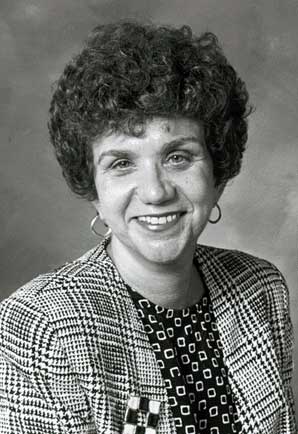
|
|
Elaine Sloan
|
After 13 years as Vice President for Information Services and University Librarian, during which time she guided Columbia's library and academic information system through whirlwind change brought on by the digital age, Elaine Sloan will retire July 2001.
When Sloan assumed leadership of Columbia's Libraries and Information Services in 1988, the system's collections numbered 5.8 million and electronic resources and digital service were a future promise. Today, Columbia's system, the ninth largest research library in North America, holds more than 7 million volumes, 26 million manuscripts, thousands of current journals and counts CD-ROMs, data files, sound recordings, and an expansive portfolio of electronic journals among its collections. For Elaine Sloan, being University Librarian has meant much more than book acquisitions and preserving collections.
"Elaine's tenure has been a remarkable period for our University's information services," said Provost Jonathan Cole. "During a time of exponential change in information technologies, Elaine has managed these changes and our ever-growing demands with great skill, never forgetting the importance of libraries as spaces for learning and intellectual exchange."
As libraries were catapulted into the digital age, Sloan was at the forefront providing a breadth of vision and a strategic sense that helped to create what we consider Columbia University Libraries to be today--an information reservoir that is accessible anytime, anywhere. She entered on the scene as AcIS began development of Columbia's robust network, which has had a dramatic impact on the way Columbians seek and utilize knowledge. And as Columbia expanded onto the Internet, so did the library system through the Digital Library project, which has further integrated the campus community through its growing collection of digital information and tools. Sloan also oversaw the development of electronic classrooms in collaboration with faculty, the Registrar and Facilities.
"Elaine has had an incredible range of vision that has enabled her to seed, house and advise the development of projects that otherwise would not have grown without her direction," said Judith Klavans, director for the Center for Research in Information Access housed by the Libraries.
Over the past decade, the library system under Sloan's direction has become a hot bed for collaboration between people internal and external to Columbia. One of the seeds sown was the landmark Electronic Publishing Initiative at Columbia (EPIC), a working partnership between the library system, AcIS and Columbia University Press that keeps Columbia at the forefront of electronic publishing with the creation of new kinds of Internet-based scholarly publications. The libraries also contributed to the birth of the Columbia Center for New Media Teaching and Learning (CCNMTL) housed in Butler Library, which supports faculty in the exploration, development, and application of digital technologies to enhance teaching and learning in the digital age. With the creation of the Center for Research in Information Access, which builds interdisciplinary research projects between the libraries, AcIS and academic departments, services are kept current as the climate adds digital libraries to existing services and operations.
In another novel partnership, Columbia, the New York Public Library and Princeton University agreed last year to build a high-tech, automated book storage facility, which will soon provide climate-controlled space for millions of volumes and assist all three institutions in alleviating the overcrowding of collections.
As information technology at Columbia has been brought up to speed, so has the physical condition of the libraries with Sloan the helm. The day of her arrival in 1988, Sloan began planning for one of Columbia's crowning achievements, the $70-million renovation of Butler Library, which has recaptured the original grandeur of the historic building and transformed the flagship library into a 21st century facility with the addition of the latest in information technologies. The Philip Milstein Family College Library, housed in several of the newly renovated 24-hour reading rooms on the 2nd and 4th floors of Butler, is almost complete and the renovation and collections selection for 10 thematic reading and research rooms, a collaborative project with Columbia faculty, will soon provide space on floors 5-8 for graduate students and faculty. In addition to Butler Library, renovations have brought improvements throughout the 22 library system.
As buildings have been refreshed for the new generation, the quality of library information and services have achieved new heights through the commitment and growing contributions of Sloan's staff. "Our gifted and dedicated staff are what makes all of this work," said Sloan, who oversees a staff of 500.
When Sloan looks out over more than two decades of library and information services management, the most interesting piece has been the resurgence of the library as "place."
"All our libraries are heavily used, not just for academic purposes but also as social space, where people get together," said Sloan "It is interesting how, in the age of technology where you can do many things on the net, people want to be together." Some would argue that the resurrection of the library at Columbia has come in part because of her.
When the academic year ends, Sloan will spend her time doing the many things that time has not allowed over the years, like traveling and becoming more familiar with New York City. "I view retirement as the beginning of the next chapter of my life," said Sloan.
|
